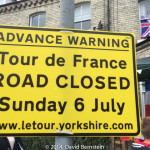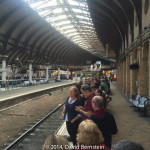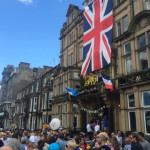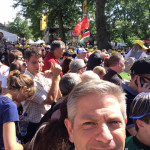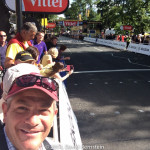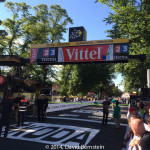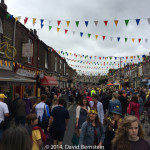A Fred in Yorkshire
Aug 9th, 2014 | By Fredcaster | Category: Blog, Races, Tour de France, TravelThe FredCast at the Tour de France
I hate crowds. Forty years of living in Southern California can do that to a person, but my particular aversion to crowds is especially heightened on Fourth of July weekend. I am fairly certain that this all stems from three specific and identifiable events.
The first was a July 4th weekend handbag sale held at the Wilshire Boulevard location of Saks Fifth Avenue in Beverly Hills. My mother dragged me to this bacchanal of leather, suede and canvas early one morning when I was about seven years old, and believe me when I tell you that hammerhead sharks even in the most intense feeding frenzies have nothing on those (ahem!) ladies.
The second event took place in 1982 when I, along with more that a half million other Southern California residents, spent the night camping on Rogers Dry Lake Bed, adjacent to Edwards Air Force Base to witness the July 4th arrival of the space shuttle Columbia, a speech by President Reagan, and the departure (atop a converted 747) of the space shuttle Challenger. Once these events concluded, we spent hours baking in hot cars trying to exit the sun-baked parking area through a single-lane exit.
And in the third instance, my wife and I foolishly took our 3- and 6-year-old daughters to Disneyworld in Orlando on July 4th, 1999. The park was so overcrowded that day, and Main Street USA so clogged with sweating humanity, that cast members were forced to allow guests “backstage†just so that we could exit the park. To this day, I break out in a cold sweat when I smell cotton candy and sunscreen.
So why, therefore, did this enochlophobic (yes, I looked that up) American intentionally place himself at the epicenter of arguably the largest July 4th weekend crowds he’ll ever experience in his lifetime? Two words: Le Tour!
About a week before the 2014 Tour de France was scheduled to begin, I convinced my wife to allow me to use some of my frequent flier miles and hotel points to spend July 4th weekend in the country from whom America had won its independence more than two centuries earlier. Without waiting for her to change her mind, I immediately set about booking my flights, hotels, and trains.
With the logistics done, I contacted the Amaury Sports Organization (ASO), the owners and organizers of the Tour de France, to obtain the media credentials that would allow me access to the press-only areas at each stage’s start and finish, as well as other areas normally off-limits to the general public, thereby ensuring my avoidance of a crowd. Imagine my disappointment, therefore, when I learned that ASO had closed accreditation days earlier. The press liaison was apologetic, but inflexible, no matter how many strings I tried to pull or connections I tried to exploit. But this was the Tour de France, the holy grail of cycling fandom, so I steeled myself against my fears and forged ahead with my plans.
Fast forward to Saturday, July 5 and I found myself standing in a long queue on a train platform in York, hoping for more room on the next train to Harrogate (the finishing city for Stage 1) than on the previous two trains that had already come and gone. Despite my feelings about being among large masses of people, I am also (perhaps ironically so) an unapologetic people watcher. With nothing else to do but wait, I began to scan the crowd.
Scattered among the throng were fans wearing their replicas of the maillot jaune, the yellow jersey that signifies the leader of the Tour de France, others wearing the polka dots of the King of the Mountains, and a smattering of people wearing their pro team jerseys, mostly from the home country favorite Team Sky. These were clearly hard core cycling fans and Freds, all of whom were looking forward to seeing the familiar faces of their pro cycling heroes.
The majority of the would-be passengers, however, were new to the world of professional cycling. I listened to their conversations, and chatted with some of them, learning that they were heading to Harrogate to experience the sights, sounds, emotions, and spectacle of the day, rather than to cheer on any one particular team or rider. These folks were proud to showcase the UK, Yorkshire, its roads, cities and towns, and while they knew the names Cavendish, Froome, and Wiggins  “I hope Sir Bradley wins this year,†one novice confided in me, not knowing the controversy surrounding Team Sky’s roster for this year’s race  they probably couldn’t pick them out of a police lineup.
At long last, the York station staff and the employees of East Coast Main Line railroad (all of whom were wearing yellow polo shirts in honor of the Yorkshire Grand Depárt) mustered an engine and enough carriages to accommodate all of us, and we headed to Harrogate. Once there, I joined a river of humanity flowing through the streets of the city, cutting a path directly to the finish line, eventually emptying into a reservoir of people dammed up by large metal barriers that separate the fans from the race course. Along the way, I passed more yellow bicycles than I could count. It seemed that every home and shop had been decorated in some way to welcome Le Tour to Yorkshire.
Although the peloton wasn’t expected for at least another three hours, the crowd was already 8-deep as far as the eye could see, so I found a spot just fifty meters from the finish line that seemed like it would be a good vantage point. With so many people arriving all the time, I resigned myself to the fact that I shouldn’t move from that spot until well after the conclusion of the day’s stage.
In Harrogate, the proportion of cycling fans to casual spectators mirrored that of the train passengers, and as I looked around the buildings surrounding the finishing stretch all I could see were yellow bicycles, replicas of the Tour’s colorful jerseys, the Union Jack of Great Britain, and people on every roof and patio, or hanging out of every window. Even the churches were adorned in yellow. Clearly, Harrogate had embraced the Tour.
As we awaited the arrival of the race we were entertained by huge video screens showing the French TV feed from the race course, with its graphics translating, and thereby re-naming, famous English landmarks, much to the amusement of those around me. On-site announcers (in both English and French) provided occasional updates of the situation on the road, including the day’s heroics by fan-favorite Jens Voigt who would end the day in polka dots, despite being the peloton’s oldest racer this year (go forty-somethings!).
Increasing the crowd’s anticipation was the arrival of one of the Tour de France’s most unique and, at times, bizarre spectacles: the promotional caravan. Electro-pop music blared from hidden speakers, as dozens of vehicles-cum-floats adorned with sponsors’ logos, performers, and people throwing all manner of trinkets and souvenirs, zoomed past in a technicolor blur. The loudest applause was saved for Yorkshire Tea, from whose floats volunteers tossed packets of commemorative Tour de France tea to appreciative supporters. This is Yorkshire, after all.
Some time after the advertising cavalcade passed the finish line, Mr. Shutuplegs was absorbed by the chasing horde, and the teams of the sprinters began jockeying for position at the front of the peloton. The cadence and energy of the on-site announcers quickened as the charging racers ticked off the kilometers. Every time it was announced that either Team Sky or Omega Pharma Quick Step had come to the front of the group, the mostly-uninitiated crowd went wild, assuming this meant that surely Chris Froome or Mark Cavendish would win the day’s stage.
Just as the tête de la course entered the outskirts of Harrogate and the cacophony of the hometown crowd reached its zenith, I looked around and realized that the crowd was now at least 25 deep for what seemed a mile in each direction, each body pushing to get closer and closer to the barriers for a better view. Perhaps it was the enthusiasm and friendliness of the people around me, or the excitement I felt at witnessing my first Tour de France in person, but I couldn’t have been more comfortable had I been watching the race from my couch back home.
It was at that point that several of the people between me and the race course suddenly got taller; it turns out many of them had come prepared with stools and step ladders to ensure that they (but not those behind them) could have a good view of the action. Normally that might infuriate me. This day, however, I laughed in appreciation of their inventiveness.
As the riders passed the flamme rouge, the red flag that signifies the spot one kilometer from the finish line, with the crowd encouraging a single rider, Mark Cavendish, to win the day, Fabian Cancellara attacked the group and for a moment it looked like he might be able to remain clear and steal victory from the Manx Missile. It was then that I heard a voice whispering in my left ear. It was a female voice, and it sounded like she was praying.
“Come on boy! Oh, please let him win! Go Mark! Oh, I hope he wins!â€Â
I looked beside me and saw a woman in her 60s, clearly not a cycling fan, who had wedged her way into the crowd hoping to see a Cavendish win.
Looking back to the big screens, Cancellara was caught and the crowd went wild. The praying of the woman next to me (“come on boy, oh come on!â€Â) was soon drowned out as nearly everyone in the crowd began yelling Cavendish’s name.
And then it happened. Cavendish, perhaps in a moment of lost focus or in his zeal to win here in Harrogate, where his mother lives, went down. Hard. I heard it before I even saw it. No, not the crash, but the sound of a disappointed, concerned nation whose hopes for a Cavendish win here in Yorkshire were dashed just 250 meters from the finish line.
Within seconds, the peloton zoomed past. From my vantage point it was nearly impossible to see who had won. At that point, in fact, much of the crowd wasn’t even watching; they were too caught up in discussing Cav’s crash, thereby making it impossible to hear the on-site announcers as they excitedly announced Marcel Kittel’s stage win and that he would soon be presented with the race’s first yellow jersey by Kate, Duchess of Cambridge, in her anachronistically green dress.
By the end of the day it was announced that more than one million people had been on-site to view Stage 1, and I would join more than two million for Stage 2 as it wound its way from York to Sheffield. I wasn’t able to attend Stage 3 from Cambridge to London (had to head back home to my day job, unfortunately), but there were millions that day too.
I thought I knew a lot about bicycle racing and spectating prior to the short time I spent in Yorkshire over Fourth of July weekend 2014. Thanks to my connections in the bicycle industry I have been fortunate to witness multiple Tours of California and Utah from within the race caravan and press areas, providing close-up views of the racers as they gut it out in bad weather, up brutal climbs, and try desperately to maintain breakaways.
On the streets of Harrogate and York, however, I learned that a bike race isn’t just about nearly two hundred people in colorful uniforms on top-of-the-line bicycles. Bicycle racing, like all professional sports, is a show put on for the entertainment and delight of the fans and spectators and sometimes, as it was in Yorkshire last weekend, it is as much a story of those spectators, as it is about the racers themselves. For many of those spectators, it didn’t matter who won or lost. What mattered was that they had become part of an event of superlatives (most watched, most difficult, longest, highest) and that they themselves had become a superlative of their own: most welcoming.
I still hate crowds. In the future, though, if someone suggests that I join a crowd a million or more strong for a French bicycle race in Yorkshire, I would go without hesitation.

